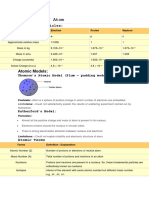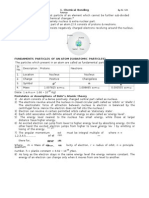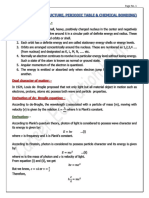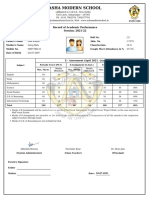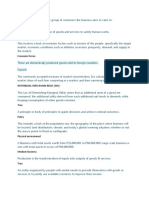www.biomentors.
online
CRASH NOTES: NEET 2024
JHJHJ
Sub.: Chemistry Topic: STRUCTURE OF ATOM
om
l.c
ai
gm
12@
12
ya
ag
r
t ip
a ga
pr
1|Biomentors.online
1
1
� www.biomentors.online
Sub-atomic Particles
Name Symbol Absolute Relative Charge Mass/kg Mass/u Approx
Charge mass/u
Electron e -1.6 x 10-19 -1 9.1 x 10-31 0.00054 0
Proton p 1.6 x 10-19 +1 1.67 x 10-27 1.00727 1
Neutron n 0 0 1.67 x 10-27 1.00867 0
Atomic Models
Thomson Model of atom
om
o Also known as plum Pudding model, raisin
pudding model and water melon model
l.c
o An atom considered to be positively
charged sphere where e- is embedded
inside it.
ai
o Drawback: It cannot explain stability of an
gm
atom.
Rutherford’s Nuclear Model of atom
2@
o Experiment:
o For the experiment a very thin sheet of gold foil was
1
bombarded by (alpha) particle. Mostly 𝛼 particles
12
shoot right through the foil. Some particles get
deflected or scattered. Very few 𝛼 particles turned
ya
back.
Findings:
ag
o Positive charge and most of the atom's mass is concentrated in the nucleus. Electrons move
r
around nucleus in a circular path called orbit. Electrons and nucleus are held together by
ip
attractive electrostatic force.
t
Nucleus:
ga
o In the nucleus, neutrons and protons are present together known as Nucleons. Nucleus has a
diameter of the order of 10– 12 to 10– 13 cm and the atom have a diameter of the order of 10–8
a
cm.
pr
Atomic Number (Z): Number of protons (p) in the nucleus of an atom.
Atomic Mass(A): Number of protons (p) + number of neutrons(n)
Term Definition Examples
Isotopes Atoms of the same element with → 1𝐻1 , 1𝐻 2 , 1𝐻 3
different neutron. → 6𝐶12 , 6𝐶 14
2|Biomentors.online
2
� www.biomentors.online
40 40
Isobar Species with same mass number → 18𝐴𝑟 , 20𝐶𝑎
but different atomic number. → 6𝐶14 , 7𝑁14
Isotone Species having same number of → 2𝐻𝑒 4 , 1𝐻 3
30
neutrons. → 14𝑆𝑖 , 15𝑃31 , 16𝑆 32
Isoelectronic Species having same number of → 𝐹 − , 𝑂2− , 𝑁𝑎+ , 𝑀𝑔2+
electrons.
Isostere Different species in which number →CO2 , N2O
of atoms and number of electrons
are same
Isodiaphere Species with same difference in the →92U235, 90Th
231
number of Neutrons & protons.
om
Isomorphs Species having same crystalline → K 2 SO4 ∙ Al2 (SO4 )3 ∙ 24H2 O
structure and K 2 SO4 ∙ Cr2 (SO4)3 ∙
24H2 O
l.c
MPQ.1. Which one of the following is isoelectronic with CO2
ai
(a) 𝑁𝑂2 (b) 𝑂22−
(c) 𝑁2 𝑂 (d) 𝑁𝑂
gm
Sol: Ans.: C
C6 8O2
-
= 22 e
2@
N2O ⇒ 7 + 7 + 8 = 22
22 e- in CO2 matches with N2O
1
MPQ.2. In case of isoelectronic species the size of F- , Ne and Na+ is affected by:
12
(a) Principal quantum number (n)
(b) None of the factors because their size is the same
ya
(c) Electron-electron interaction in the outer orbitals
(d) Nuclear charge (z)
ag
Sol: Ans (4)
In F- , Ne , Na+ all have 1𝑠 2 , 2𝑠 2 , 2𝑝6 configuration. They have different size due to the
r
difference in nuclear charge.
ip
(Niels Bohr) Bohr’s atomic model: -
t
ga
o Bohr’s model of atom: Different atomic models were proposed to explain the distribution of
charged particles in an atom.
h
a
o Angular momentum of an electron: mvr = n 2π
pr
n2
o Radius of stationary state of hydrogen – like species : rn = Z × 52.9 pm
Z2 −18
Z2 Z2
En = − 2 × 2.18 × 10 J OR − 2 × 1312 kJ or − 2 × 13.6 eV
n n n
o Velocity of electron in nth shell of hydrogen – like species:
Z
vn = × 2.188 × 108 cm/sec
n
Z2 Z2
o Ionisation energy: I.E. = E∞ − En = n2 × 2.18 × 10−18 J or n2 × 13.6 eV
3|Biomentors.online
3
� www.biomentors.online
MPQ.3. In the first orbit of an atom the velocity of electron is 𝒙 𝒄𝒎/𝒔𝒆𝒄. What is its velocity in 3rd orbit?
𝑥 𝑥
(1) 3 (2) 9
(3) 3𝑥 (4) 27𝑥
Ans.: (1)
1
V∝n
1
V∝
3
Orbit (Shell) and Sub shell
o Circular path of definite energy is called orbit.
o The main energy level is split into different fine line known as Sub – shell
om
o Number of sub shell = n-orbit
Orbit Number of sub shell Max 𝒆− (𝟐𝒏𝟐 )
1−𝐾 1 − 1𝑠 2
l.c
2−𝐿 8
ai
gm
3−𝑀 2@ 18
4−𝑁 32
1
12
Orbitals: -
ya
Subshell Orbitals Maximum Shape
ag
no of 𝒆−
s s 2
r
t ip
ga
p 𝑝𝑥 , 𝑝𝑦 ,𝑝𝑧 6
a
pr
d 𝑑𝑥𝑦 , 𝑑𝑦𝑧 , 𝑑𝑥𝑧 , 10
𝑑𝑥 2 −𝑦2 , 𝑑𝑧2
f-subshell: It constitute 7 orbitals, has Complex – shape (triple dumb-bell) and can accumulate a
maximum of 14 e-.
4|Biomentors.online
4
� www.biomentors.online
MPQ.4. Given below are two statements:
Statement-I: The orbitals having same energy are called as degenerate orbitals.
Statement-II: In hydrogen atom, 3p and 3d orbitals are not degenerate orbitals.
In the light of the above statements, choose the most appropriate answer from the options
given
(1) Statement-I is true but Statement-II is false
(2) Both Statement-I and Statement-II are true.
(3) Both Statement-I and Statement-II are false
(4) Statement-I is false but Statement-II is true
Ans. (1)
Nodal surface:- The space present between two s-orbitals where the density of electron is zero No.
of nodal surface = (𝒏 − 𝟏)
om
e.g., nodal surface in 2s orbital = (2 − 1) = 1
Nodal plane: - The total number of nodes are given by (n–1), i.e., sum of l angular nodes and (n -l-1)
l.c
radial nodes
Important formulas:-
ai
o Spherical nodes = n − l − 1
o Angular node nodes = 𝑙
gm
Note- Spherical nodes are also called radial nodes
2@
MPQ.5. The number of radial node/s for 3p orbital is:
(1) 1 (2) 4
(3) 2 (4) 3
1
Ans (1)
12
For 3p : n = 3, 𝑙= 1
Number of radial node = n – 𝑙 – 1
ya
=3–1–1=1
Electronic configuration: -
ag
Aufbau principle: In the ground state of the atoms, the orbitals are filled in order of their increasing
energies. Is, 2s, 2p, 3s, 3p, 4s, 3d, 4p, 5s, 44, 5P, 6s, 4f, 5d, 6p, 7s........
r
Pauli exclusion principle : No two electrons in an atom can have the same set of four quantum
ip
numbers. OR "only two electrons may exist in the same orbital and these electrons must have
t
opposite spin."
ga
Hund's rule of maximum multiplicity: Pairing of electrons in the orbitals belonging to the same
subshell (p, d or f) does not take place until each orbital belonging to that subshell has got one
a
electron each i.e. it is singly occupied.
The completely filled and half-filled subshells are extra stable due to symmetrical distribution of
pr
electrons and high exchange energy.
MPQ.6. The shape of orbital with value 𝐥 = 𝟐, 𝐦 = 𝟎.
(a) spherical (b) dumb-bell
(c) double dumb-bell (d) square planar
Ans. (c)
l = 2 for d-orbital, therefore double-dumb-bell in shape
5|Biomentors.online
5
� www.biomentors.online
−
MPQ.7. The maximum number of 𝐞 present in subshell having azimuthal quantum number 𝐥 = 𝟑.
(a) 0 (b) 2
(c) 10 (d) 14
Ans. (d)
f-orbital.
MPQ.8. Which one of the following quantum numbers represent impossible arrangement.
𝐧 𝐥 𝐦 𝐬
1
a 3 2 −2
2
1
b 4 0 0 +
2
om
1
c 3 2 −3 +
2
1
l.c
d 5 3 −3 +
2
Ans. (c)
ai
gm
Magnetic nature :
o All those elements or species containing unpaired electron are called Paramagnetic.
o All those elements or species with no unpaired electron are called Diamagnetic.
2@
Magnetic momentum (चम्
ु बकीय आघर्
ू )ण :-
𝛍 = √𝐧(𝐧 + 𝟐) B.M
1
B. M = ‘Bohr Magneton’ , n = number of unpaired electron
12
e.g. Ni2+ → 4so 3d8 - 2 unpaired electron
ya
Quantum number: -
Number Symbol Possible values
ag
Principal Quantum number 𝒏 1, 2, 3, 4
Angular Momentum Quantum 𝒍 0, 1, 2, 3, ........(n-1)
number
r
ip
Magnetic Quantum number 𝒎𝒍 −𝑙, … … … , −1 , 0 , 1, … 𝑙
Spin Quantum number 𝒎𝒔 1 1
t
+ ,−
2 2
ga
MPQ.9. The four quantum numbers for the electron in the outer most orbital of potassium (atomic
a
no. 19) are
pr
1
(1) 𝑛 = 4 , 𝑙 = 2 , 𝑚 = −1, 𝑠 = + 2
1
(2) 𝑛 = 4 , 𝑙 = 0 , 𝑚 = 0 , 𝑠 = + 2
1
(3) 𝑛 = 3, 𝑙 = 0 , 𝑚 = 1 , 𝑠 = + 2
1
(4) 𝑛 = 1 , 𝑙 = 0 , 𝑚 = 0 , 𝑠 = + 2
Ans (2)
2 2 6 2 6 1
19𝐾 1𝑠 , 2𝑠 , 2𝑝 , 3𝑠 , 3𝑝 , 4𝑠
Outermost orbital of potassium is 4s orbital
6|Biomentors.online
6
� www.biomentors.online
1
𝑛 = 4 , 𝑙 = 0 , 𝑚1 = 0 , 𝑠 = ±2
Planck’s Quantum Theory:
o Atoms and molecules can emit (or absorb) energy only in discrete quantities and not in a
continuous manner. The smallest quantity of energy that can be emitted or absorbed in the
form of electromagnetic radiation is called quantum and the energy associated with a
quantum is proportional to its frequency i.e. E = h𝝊, where h is Planck's constant having value
equal to 6.626 x 10-34 J s.
o Black body radiation: The ideal body, which emits and absorbs all frequencies, is called a
black body and the radiation emitted by such a body is called black body radiation.
o Photoelectric effect:- The Ejection of free electron from metal surface, when light of suitable
frequency strikes on it.
om
o Kinetic energy of ejected electron is given as:
1
ℎ𝜐 = ℎ𝜐0 + 𝑚𝑒 𝒱 2
2
l.c
ℎ𝜐0 is called work function (minimum energy required to eject the electron).
ai
de - Broglie’s wave equation: -
h ℎ
gm
λ= =
mv 𝑝
MPQ.10. According to the wave-particle duality of matter by de-Broglie, which of the following
graph plot presents most appropriate relationship between wavelength of electron (X) and
2@
momentum of
1
12
ya
rag
t ip
ga
Ans (1)
a
pr
Heisenberg’s uncertainty principle :
h h
Δx × ∆p ≥ 4π or Δx × ∆v ≥ 4πm where ∆x is uncertainity in position and ∆p or ∆v is uncertainity
in momentum or velocity.
7|Biomentors.online
7
� www.biomentors.online
Schrodinger’s wave equation:
∂2 ψ ∂2 ψ ∂2 ψ 8π2 m
+ + + (E − V)ψ = 0
∂x 2 ∂y 2 ∂z 2 h2
∂2 ψ
where 𝜓 is the amplitude of wave or waver function and ∂x2 is second derivative of ψ w.r.t and so
on, x, y, z are the coordinates, m is mass of electron, h is Planck’s constant, E is the total energy and
V is the potential energy of the electron.
ψ𝟐 = Probability factor:- Which determines the density of electrons in a particular volume like the
probability of presence of electron in orbitals is 90 to 95 %
Hydrogen Spectrum:
om
1 1 1
= 𝑅𝑍 2 ( 2 − 2 )
𝜆 𝑛1 𝑛2
R = Rydberg’s constant 109678/cm
l.c
Z = atomic number
n1, n2 = Energy level
ai
S. No. Line Zone 𝐧𝟏 𝐧𝟐 = (𝐧𝟏 + 𝟏) 𝐭𝐨
∞
gm
1. Lyman UV 1 2, 3, 4, 5
2. Balmer Visible 2 3, 4, 5
3. Paschen I. R 3 4, 5, 6
2@
4. Brackett I. R 4 5, 6, 7
5. Pfund I. R 5 6, 7, 8
1
6. Humphries I. R 6 7, 8, 9
12
n(n−1)
1. No. of spectral lines = 2
ya
2. Where n = orbit
ag
MPQ.11. Match List I with List II
r
t ip
a ga
pr
Choose the correct answer from the options given below :-
(1) A-II, B-III, C-I, D-IV (2) A-I, B-III, C-II, D-IV
(3) A-II, B-IV, C-III, D-I (4) A-I, B-II, C-III, D-IV
Ans. (3)
8|Biomentors.online
8
� www.biomentors.online
NEET Previous Years Questions Exercise
1. Select the correct statements from the following [2023]
A. Atoms of all elements are composed of two fundamental particles.
B. The mass of the electron is 9.10939 10-31 kg.
C. All the isotopes of a given elements show same chemical properties.
D. Protons and electrons are collectively known as nucleons
E. Dalton's atomic theory, regarded the atom as an ultimate particle of matter.
Choose the correct answer from the options given below.
(a) C, D and E only (b) A and E only
(c) B, C and E only (d) A, B and C only
om
2. If radius of second Bohr orbit of the He+ ion is 105.8 pm, what is the radius of third Bohr orbit of
Li2+ ion? [2022]
(a) 15.87 pm (b) 1.587 pm
l.c
(c) 158.7 Å (d) 158.7 pm
ai
3. A particular station of All India radio, New Delhi broadcasts on a frequency of 1,368 kHz
gm
(kilohertz). The wavelength of the electromagnetic radiation emitted by the transmitter is:
[speed of light c = 3.0 × 𝟏𝟎𝟖 𝒎𝒔−𝟏 ] [2021]
(a) 21.92 cm (b) 219.3 m
2@
(c) 219.2 m (d) 2192 m
1
4. In hydrogen atom, the de – Broglie wavelength of an electron in the second Bohr orbit is
12
[Given that Bohr radius, a0 = 52.9 pm] [2019]
(a) 105.8 pm (b) 211.6 pm
ya
(c) 211.6 𝜋 pm (d) 52.9 𝜋 pm
ag
5. Which of the following series of transitions in the spectrum of hydrogen atom falls in visible
region? [2019]
r
(a) Lyman series (b) Blamer series
ip
(c) Paschen series (d) Brackett series
t
ga
6. According to law of photochemical equivalence the energy absorbed (in ergs/mole) is given as
(h = 6.62 × 𝟏𝟎−𝟐𝟕 𝐞𝐫𝐠𝐬, 𝐜 = 𝟑 × 𝟏𝟎𝟏𝟎 𝐜𝐦 𝐬 −𝟏 , 𝐍𝐀 = 𝟔. 𝟎𝟐 × 𝟏𝟎𝟐𝟑 𝐦𝐨𝐥−𝟏 ) [2019]
a
2.859 105 1.196 108
pr
(a) (b)
2.859 1016 1.196 1016
(c) (d)
7. Orbital having 3 angular nodes and 3 total nodes is [2019]
(a) 6d (b) 5p
(c) 3d (d) 4f
9|Biomentors.online
9
� www.biomentors.online
8. 4d, 5p, 5f and 6p orbitals are arranged in the order of decreasing energy. The correct option is:
[2019]
(a) 5f > 6p > 5p > 4d (b) 6p < 5f < 5p < 4d
(c) 6p < 5f < 4d < 5p (d) 5f < 6p < 4d < 5p
9. Which one is a wrong statement? [2018]
(a) Total orbitals angular momentum of electron in ‘s’ orbital is equal to zero
(b) An orbital is designated by three quantum numbers while an electron in an atom is designated
by four quantum numbers
(c) The value of m for 𝑑𝑍2 is zero
(d) The electronic configuration of N atom is
om
l.c
ai
Answer key
gm
Ques. 1. 2. 3. 4. 5. 6. 7. 8. 9.
Answer (c) (d) (b) (c) (b)
2@ (b) (d) (a) (d)
Hints & Solutions:
1
1. It is statement based question
Statement B, C & E are correct
12
(B) Mass of the electron is9.10939 × 10-31 kg
(C) All the isotopes of given elements show same chemical properties
ya
(E) Dalton's atomic theory, regarding the atom as an ultimate particle of matter
2. According to Bohr’s atomic model
ag
𝑛2
𝑟∝ 𝑧
3rd orbit of Li2+ n1 = 3
r
z1 = 3
ip
⇒ 2nd orbit of He+ n2 = 2
z2 = 2
t
n21
ga
(r3 )Li+2 z2
= ×
(r2 )He+ n22 z1
(r3 )Li2+ (3)2 2
a
= (2)2 ×
105.8 pm 3
pr
(r3 )Li2+ = 158.7𝑝𝑚
3. Given v = 1,368 kHz
= 1368 × 103 Hz
𝑐
Wavelength = 𝑣
3 × 108
= 1368 ×103
= 219.3 𝑚
4. n𝜆 = 2 𝜋𝑟
2𝜋
𝜆= 𝑛
𝑟
10 | B i o m e n t o r s . o n l i n e
10
� www.biomentors.online
2
rn = a0n
r2 = 52.9 × (2)2 pm
2𝜋
∴𝜆= 2
× 52.9 × 4
𝜆 = 211.6 𝜋 𝑝𝑚
5. Blamer series
ℎ𝑐
6. E = 𝜆
× 𝑁𝐴
6.62 × 10−27 × 3 × 1010 × 6.02 × 1023
= 𝜆
1.196 × 108
= 𝜆
𝑒𝑟𝑔𝑠 𝑚𝑜𝑙 −1
om
7. Total number of nodes = (n – 1)
3=n–1⇒ n=4
Number of angular nodes = 1 = 3 ⇒ f – subshell
l.c
8. 5f 5+3=8
6p 6+1=7
ai
5p 5+1=6
4d 4+2=6
gm
5f > 6p > 5p > 4d
9. The correct configuration of ‘N’ is
1 2@
12
ya
r ag
t ip
a ga
pr
11 | B i o m e n t o r s . o n l i n e
11











